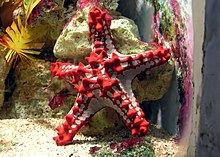Starfish are among the most familiar of marine animals found on the seabed. They typically have a central disc and five arms, though some species have many more arms than this. The aboral or upper surface may be smooth, granular or spiny, and is covered with overlapping plates. Many species are brightly coloured in various shades of red or orange, while others are blue, grey, brown, or drab. Starfish have tube feet operated by a hydraulic system and a mouth at the centre of the oral or lower surface. They are opportunistic feeders and are mostly predators on benthic invertebrates. Several species having specialized feeding behaviours, including suspension feeding and adaptations for feeding on specific prey. They have complex life cycles and can reproduce both sexually and asexually. Most can regenerate damaged or lost arms.
The Asteroidea occupy several important ecological roles. Starfish, such as the ochre sea star (Pisaster ochraceus), have become widely known as an example of the keystone species concept in ecology. The tropical crown-of-thorns starfish (Acanthaster planci) is a voracious predator of coral throughout the Indo-Pacific region. Other starfish, such as members of the Asterinidae, are frequently used in developmental biology.
Symmetry
Starfish are radially symmetric and typically express pentamerism or pentaradial symmetry as adults. However, the evolutionary ancestors of echinoderms are believed to have had bilateral symmetry. Modern starfish, as well as other echinoderms, exhibit bilateral symmetry in their larval forms.
Most starfish have five rays or arms, which radiate from a central disc. However, several species frequently have six or more arms. Several asteroid groups, such as the Solasteridae, have 10 to 15 arms, while some species, such as the Antarctic Labidiaster annulatus can have up to 50. It is not unusual for species that typically have five arms to exceptionally possess six or more through abnormal development.
Body Wall
The body wall consists of a thin cuticle, an epidermis consisting of a single layer of cells, a thick dermis formed of connective tissue and a thin coelomic epithelium which contains the longitudinal and circular musculature and the peritoneum. The dermis contains an endoskeleton of plate-like calcium carbonate components known as ossicles. These are honeycombed structures composed of calcite microcrystals arranged in a lattice. They vary in form, some bearing external granules, tubercles and spines, sometimes organised into definite patterns. Some are specialised structures such as the pedicellariae and paxillae. Pedicellariae are compound ossicles with forceps-like jaws and function to remove debris from the body surface, moving about on their flexible stalks in response to physical or chemical stimuli, continually making biting movements.. Paxillae are umbrella-like structures found on starfish which live buried in sediment. They meet edge to edge and form a false cuticle with a water cavity beneath in which the madreporite and delicate gill structures are protected. All the ossicles, including those projecting externally, are covered by the epidermal layer.

No comments:
Post a Comment